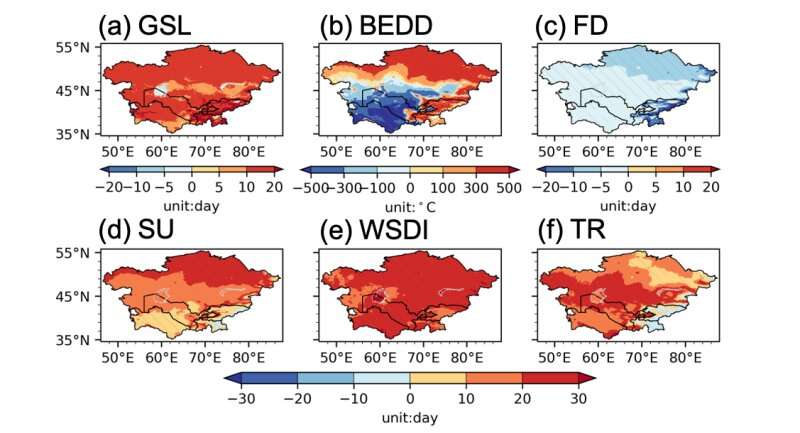Release of two new datasets related to climate in Central Asia

As one of the climate change hot spots, central Asia witnessed a significant warming in the past and is very likely to experience more heatwaves and drought events in the future.
Due to lack of high-resolution climate projection datasets, it's difficult to study the potential impacts of future climate changes on many sectors in central Asia, in particular, ecological and hydrological systems.
To tackle this problem, a research group led by Prof. Feng Jinming from the Institute of Atmospheric Physics (IAP) of the Chinese Academy of Sciences produced a 9KM resolution climate projection dataset in central Asia based on dynamically downscaling results of multiple bias-corrected global climate models, which is called HCPD-CA for short.
This dataset covers two periods: 1986–2005 and 2031–2050. It utilizes the emission scenario RCP4.5, and includes four geostatic variables and ten meteorological elements, which can be used to drive most of the ecological and hydrological models.
Related results were published in Earth System Science Data.
In the study, the HCPD-CA dataset was evaluated at various time scales. The results showed that the dataset had high accuracy in describing the historical climatology in central Asia.
In addition, the researchers assessed the projected changes (2031–2050 vs. 1986–2005) in the ten meteorology elements. They found that surface air temperature, downwelling shortwave and longwave radiation were expected to significantly increase, with minor changes in other elements.
The horizontal resolution of this dataset increases from ≥30KM to 9KM, which largely improves its accuracy, especially in the mountainous regions. Multiple global climate models are used to drive the regional climate model, which can reduce the uncertainties in the downscaled results brought by the driving data. Moreover, the climatology of the driving data is bias-corrected with the reanalysis data, which largely reduces the biases in the regional climate simulations.
Central Asia is highly agrarian. To understand the potential impacts of the projected climate changes on the local agricultures in central Asia, the research group also calculated six agroclimatic indicators and analyzed projected changes (2031–2050 vs. 1986–2005) in these indicators. The related study was published in Advances in Atmospheric Sciences.
"Agroclimatic indicators are proxies for the effect of weather and climate on specific agricultural activities and both practical and understandable to farmers and policy makers," said Prof. Feng Jinming, corresponding author of the study.
The results showed that the growing season length (GSL), summer days (SD), warm spell duration index (WSDI) and tropical days (TD) were projected to significantly increase and meanwhile the frost days (FD) were projected to significantly decrease. Projected changes in biologically effective degree days (BEDD) were spatially heterogeneous, with an increase in northern CA and the mountainous areas and a decrease in other areas.
Five of these six indicators were related to absolute temperature thresholds and were sensitive to the systematic biases in the dynamically downscaled results. "Therefore, we first applied the quantile mapping method to correct the downscaled results. We found that the bias-correction method largely reduced the biases in the indicators, which makes the projection more reasonable," said Dr. Qiu Yuan, lead author of the study.
The HCPD-CA dataset and the high-resolution projection dataset of agroclimatic indicators over Central Asia are archived at the National Tibetan Plateau Data Center.
More information: Yuan Qiu et al, HCPD-CA: high-resolution climate projection dataset in central Asia, Earth System Science Data (2022). DOI: 10.5194/essd-14-2195-2022
Yuan Qiu et al, High-resolution Projection Dataset of Agroclimatic Indicators over Central Asia, Advances in Atmospheric Sciences (2022). DOI: 10.1007/s00376-022-2008-3
Journal information: Advances in Atmospheric Sciences
Provided by Chinese Academy of Sciences



















